Consolidation Reference Manual
You can still refer to the Consolidation reference manual for consolidation information that has not been impacted by changes in the legislation.
C1 Eligibility
C1-1 Eligibility tests and rules
The consolidatable group
To consolidate, a group must consist of an Australian-resident head company and at least one wholly-owned resident subsidiary (which may be a company, trust or partnership). Certain types of company cannot be a head company or subsidiary member and certain types of trust cannot be a subsidiary member.
If a group consolidates, all of the head company's eligible wholly-owned subsidiaries must be included in the consolidated group.
A foreign-owned group of Australian-resident subsidiaries that do not have a single resident head company may instead choose to consolidate by forming a multiple entry consolidated (MEC) group. → C10-1
Figure 1: Consolidatable group
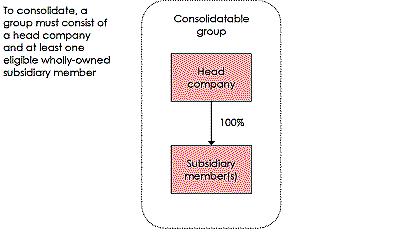
Flowchart 1 - Who can be a head company?

Flowchart 2 - Who can be a subsidiary member?
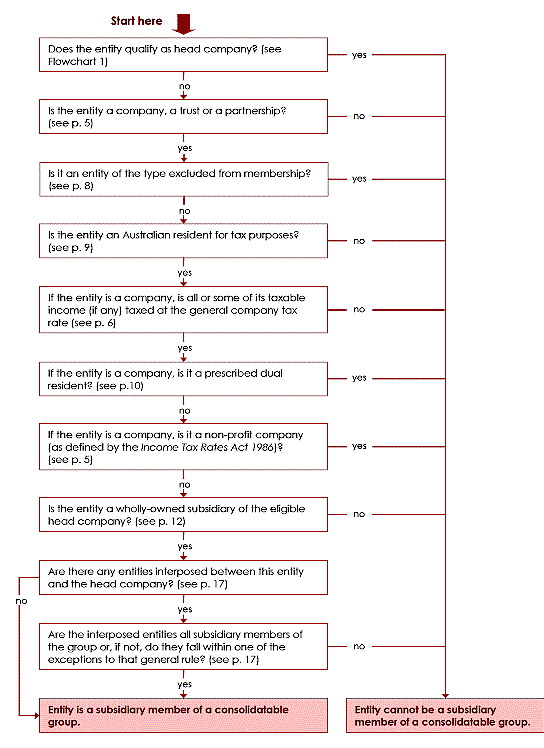
Included entities
A company
A 'company' for income tax purposes is defined in section 995-1 of the Income Tax Assessment Act 1997 (ITAA 1997) to mean:
- •
- 'a body corporate; or
- •
- any other unincorporated association or body of persons;
but does not include a partnership or a non-entity joint venture,'
As can be seen from this definition, a body does not necessarily have to be incorporated as a company for company law purposes to be a company for income tax purposes.
The terms 'company' and 'partnership' are mutually exclusive. A partnership is defined in section 995-1 of the ITAA 1997 to mean:
- •
- an association of persons (other than a company or a limited partnership) carrying on business as partners or in receipt of ordinary income or statutory income jointly, or
- •
- a limited partnership.
→ 'A partnership', p. 3
Most unincorporated clubs and associations would fall outside the definition of partnership, as they are not being conducted with a view to profit, and would therefore be companies for income tax purposes.
While a 'non-profit company' can be the head company of a consolidated group, it cannot be a subsidiary member. For an organisation such as a club, society or association to be a non-profit company:
- •
- it must be a company that is not carried on for the purposes of profit or gain to its individual members, and
- •
- its constituent documents must prohibit it from making any distribution, whether in money, property or otherwise, to its members.
→ section 3, Income Tax Rates Act 1986
Even though the terms company and partnership are mutually exclusive, a 'corporate limited partnership' is deemed to be a company and not a partnership for income tax purposes. → sections 94H - 94K of the Income Tax Assessment Act 1936 (ITAA 1936).
A limited partnership is defined in section 995-1 of the ITAA 1997 to mean:
- •
- an association of persons (other than a company) carrying on business as partners or in receipt of ordinary income or statutory income jointly, where the liability of at least one of those persons is limited, or
- •
- one of certain types of venture capital partnership (see section 995-1 for more detail).
Under the various state partnership Acts, there are four basic requirements for a limited partnership:
- •
- there must be one or more general partners liable for all the debts and obligations
- •
- there must be one or more limited partners who must contribute capital and who cannot be required to provide funds in addition to their capital contribution
- •
- the limited partner cannot draw out their capital during the continuance of the partnership, and
- •
- the limited partner cannot take part in the management of the partnership.
With the exception of certain venture capital partnerships, a 'limited partnership' will be a 'corporate limited partnership' → section 94D, ITAA 1936. It will be treated as a company for income tax purposes other than in relation to the definitions of the terms 'dividend' and 'resident' or 'resident of Australia' → section 94J of ITAA 1936. This is reinforced by section 94K of the ITAA 1936 which states that a reference to a 'partnership' does not include a reference to a 'corporate limited partnership,'
Corporate limited partnerships are public companies for tax purposes.
→ section 94N, ITAA 1936.
General company tax rate
To be either a head company or a subsidiary member of a consolidated group, a company must have at least some of its taxable income (if it has any) taxed at the general company tax rate.
The term 'general company tax rate' is defined in section 995-1 of the ITAA 97 to mean 'the rate of tax imposed on taxable incomes of companies (except companies that are registered organisations, life insurance companies and companies that are PDFs throughout the last day of the year of income)'. For the 2002-03 income year the rate is 30%.
A trust
'A trust may be defined as an obligation enforceable in equity which rests on a person (the trustee) as owner of some specific property (the trust property) to deal with that property for the benefit of a certain person (the beneficiary) or persons, or for the advancement of certain purposes.,' [F1]
The trustee may be a natural person or a company and may also be a beneficiary of the trust, provided they are not the sole beneficiary. The trustee has a personal obligation, which is fiduciary in nature (duty of care owed), to deal with the trust property for the benefit of the beneficiaries.
A trust, unlike a company, is not a separate legal entity. However, the ITAA 1936 recognises a 'trust estate' for tax purposes and may treat it as a separate entity for the purposes of performing certain calculations (such as calculating the trust estate's net income). The net income of the trust estate is then attributed to either the trustee or the beneficiaries in accordance with Division 6 of the ITAA 1936.
The members of fixed and discretionary trusts (other than corporate unit trusts and public trading trusts) are the beneficiaries, unitholders or objects of the trust. The members of corporate unit trusts and public trading trusts are the unitholders. → section 960-130: meaning of 'members of entities'
Discretionary trusts may be members of a consolidatable group, provided their objects are confined to members of the group.
A partnership
A partnership is defined in section 995-1 of the ITAA 1997 to mean:
- •
- an association of persons (other than a company or a limited partnership) carrying on business as partners or in receipt of ordinary income or statutory income jointly; or
- •
- a limited partnership.
Note that foreign hybrid companies are treated for income tax purposes as partnerships. → Division 830, ITAA 1997
The phrase 'carrying on business as partners' is based on common law principles concerning the mutual rights and obligations of the parties involved. These principles are also embedded in the state and territory partnership legislation which defines a partnership as the relationship that exists between persons carrying on business in common with a view to profit. The legislative definition in section 995-1 extends the meaning given to the word 'partnership' in common law and state and territory partnership law. An example of a partnership where the partners are not carrying on a business is joint ownership of a rental investment property.
Taxation Ruling TR 94/8 outlines factors taken into account in deciding whether persons are carrying on business as partners for income tax purposes.
Corporate limited partnerships are considered to be companies for tax law purposes. → 'Company', p. 3
Partnerships are not separate legal entities. The net income/loss of a partnership is calculated and the partners include their share of the net income/loss in their taxable income. Where the partner is an individual, they are assessed at individual marginal rates. Where the partner is a company it is assessed at the corporate tax rate.
Excluded entities
Companies that cannot be a head company or subsidiary member
The table below lists the companies that are specifically excluded from being a head company of a consolidatable or consolidated group. Essentially, these companies cannot be a head company because they receive some form of concessional tax treatment. Allowing them to be a head company would extend that concessional tax treatment to all members of the group.
| This entity ... | is excluded under ... | because ... |
|---|---|---|
| An entity that is exempt from income tax under Division 50 of the ITAA 1997 | subsection 703-20(2) ITAA 1997, table item 1. | The total ordinary and statutory income of these companies is exempt from income tax. |
| A recognised medium credit union (as defined by section 6H of the ITAA 1936). | subsection 703-20(2), table item 2. | These credit unions have a threshold placed on the tax payable on their taxable income, even though they are subject to the corporate tax rate. |
| An approved credit union (as defined under section 23G of the ITAA 1936) that is not a recognised medium or large credit union (as defined under section 6H of the ITAA 1936). | subsection 703-20(2), table item 3. | These credit unions are entitled to an exemption under section 23G of the ITAA 1936 for interest received from non-corporate members. |
| An entity that is a pooled development fund (PDF) (as defined under section 995-1 of the ITAA 1997) at the end of the income year. → paragraph 3.40 | subsection 703-20(2), table item 5. | These companies are subject to a concessional rate of tax compared to the general company tax rate. |
| A company that is a film licensed investment company (FLIC) (as defined in section 375-855 of the ITAA 1997). | subsection 703-20(2), table item 6. | Tax losses or net capital losses cannot be transferred to or from these companies. Further, section 375-880 of the ITAA 1997 prevents these companies from claiming deductions for expenditure on a film where the amount spent is FLIC concessional capital. |
Other entities that cannot be a subsidiary member
In addition to all the companies listed in the table above, there are some entities listed in the table below that are also excluded from being subsidiary members of a consolidatable or consolidated group.
| This entity ... | is excluded under ... | Because ... |
|---|---|---|
| A trust that is:
|
subsection 703-20(2), table item 7. | The taxable income of these entities is subject to tax at rates other than the general company tax rate. |
| A company that is a non-profit company (as defined in section 3 of the Income Tax Rates Act 1986). | subsection 703-15(2), table item 2. | The corporate tax rate is phased in on the taxable income of these companies. |
Companies and trusts that appear in these tables are excluded from being a subsidiary member primarily to preserve the subsidiary's concessional tax treatment (that is, the concessions would be lost if the income were assessable to the head company). In some cases exclusions also act as an integrity measure to prevent certain entities from effectively gaining relative concessional treatment. For example, the income of a non-complying superannuation fund would be concessionally taxed if it were permitted to be a subsidiary member of a consolidated group, because the taxable income of a non-complying superannuation fund is taxed at a rate higher that the general company tax rate.
Australian residency
Resident company
The statutory definition of 'Australian resident' in section 995-1 of the ITAA 1997 points to the definition of 'resident' or 'resident of Australia' in subsection 6(1) of the ITAA 1936. A company is a resident of Australia if:
- •
- it is incorporated in Australia, or
- •
- although not incorporated in Australia it carries on business in Australia and has either
- -
- its central management and control in Australia, or
- -
- its voting power controlled by shareholders who are residents of Australia.
It is clear from this definition that if a company is incorporated in Australia it will, regardless of other aspects, be treated as a resident for Australian tax law purposes. This means that regardless of where the company is found to reside within the ordinary meaning of the word under common law, a company that was incorporated in Australia will automatically be a resident of Australia under the statutory definition. The second statutory test is only triggered where the company is not incorporated in Australia. It is considered that the residency test for a company not incorporated in Australia is a composite test which requires the company to carry on business in Australia as a prerequisite and, in addition, to have either its central management and control in Australia or its voting power controlled by Australian-resident shareholders. See ATO ID 2002/46 for further discussion of this test.
The following leading cases provide guidance as to what factors need to be considered in reaching the necessary conclusion of fact as to where the central management and control is exercised:
Koitaki Para Rubber Estates Ltd v FC of T (1941) 64 CLR 241 ; 6 ATD 82
John Hood and Co Ltd v Magee (1918) 7 TC 327
Malayan Shipping Co. Ltd v FC of T (1946) 71 CLR 156 ; 8 ATD 75
Esquire Nominees Ltd v FC of T (1973) 129 CLR 177 ; 73 ATC 4114
A corporate limited partnership will be considered a resident of Australia if and only if:
- •
- the partnership was formed in Australia, or
- •
- the partnership either carries on business in Australia, or has its central management and control in Australia. → section 94T, ITAA 1936
A company will not be eligible to be a member of a consolidatable or consolidated group unless it is an Australian resident (and it cannot be a 'prescribed dual resident'). → subsection 703-15(2), table column 3, ITAA 1997; Taxation Determination TD 2004/42
Prescribed dual resident company
Prescribed dual resident companies are precluded from being members of a consolidatable or consolidated group. → subsection 703-15(2), table items 1 and 2, column 3
A 'prescribed dual resident' is defined in subsection 6(1) of the ITAA 1936 and essentially means a company that qualifies as an Australian resident (as discussed above) but:
- •
- is treated as being a resident solely of another country under tie-breaker rules in a double tax agreement, or
- •
- qualifies as an Australian resident solely because its central management and control is in Australia and it carries on business here, but is also regarded as a resident of another country with its central management and control in another country.
Partnerships - no residency requirement
The consolidation legislation imposes no residency requirement on partnerships → column 3 of table in subsection 703-15(2). This is because, in a consolidation context, a partnership whose partners are subsidiary members (having satisfied the Australian residence requirements themselves) will be a resident partnership for most income tax purposes. It is therefore unnecessary to impose a further residency test on partnerships.
Resident trusts
A trust must comply with the Australian residency requirements of section 703-25 in order to be a subsidiary member → column 3 of table in subsection 703-15(2). The requirements for trusts (outlined in section 703-25 of the ITAA 1997) are as follows:
- •
- A trust (except a unit trust) must be a 'resident trust estate' for the income year for the purposes of Division 6 of Part III of the ITAA 1936; that is, the trust will be taken to be an Australian resident in any given income year if it meets the following requirements of subsection 95(2) (ITAA 1936):
- (a)
- a trustee of the trust estate was a resident at any time during the year, or
- (b)
- the central management and control of the trust estate was in Australia at any time during the year.
- •
- A unit trust (except a corporate unit trust, defined in section 102J ITAA 1936, or a public trading trust, defined in section 102R ITAA 1936) must be a resident trust estate for the income year for the purposes of Division 6 of Part III of the ITAA 1936
and
a resident trust for CGT purposes for the income year. That is, the unit trust will be taken to be an Australian resident in any given income year if it meets the following requirements of subsection 95(2) (ITAA 1936):
- (a)
- a trustee of the trust estate was a resident at any time during the year, or
- (b)
- the central management and control of the trust estate was in Australia at any time during the year,
- and it also meets the additional requirements imposed by the definition of 'resident trust for CGT purposes' in section 995-1 of the ITAA 1997 - that is, one of the requirements in column 2 and one of the requirements in column 3 of the following table must be satisfied:
| Item | One of these
requirements is satisfied |
And also one of these |
|---|---|---|
| 1 | Any property of the trust is situated in Australia. | The central management and control of the trust is in Australia. |
| 2 | The trust carries on a business in Australia. | Australian residents held more than 50% of the beneficial interests in the income or property of the trust. |
- •
- A corporate unit trust or a public trading trust must be a resident unit trust (defined in section 102H or section 102Q of the ITAA 1936 - whichever is relevant) for the income year.
Wholly-owned subsidiary
The term 'wholly-owned subsidiary' is a defined term. The general test to determine whether one entity is a wholly-owned subsidiary of another is in section 703-30 (ITAA 1997). There are also a number of other provisions that modify the operation of section 703-30 or deem an entity to be a wholly-owned subsidiary. These provisions are referred to here as 'special rules,'
The wholly-owned concept is used both in determining whether a company qualifies as a head company and whether an entity qualifies as a subsidiary member of a consolidatable group.
Wholly-owned subsidiary - the general test
The term wholly-owned subsidiary is defined in section 703-30. [F2] Under subsection (1) of that provision, an entity (the subsidiary entity) will be a wholly-owned subsidiary of another entity (the holding entity) if all the membership interests in the subsidiary entity are beneficially owned by:
- •
- the holding entity
- •
- one or more wholly-owned subsidiaries of the holding entity, or
- •
- a combination of the holding entity and one or more wholly-owned subsidiaries of the holding entity.
Subsection 703-30(2) then provides for that subsidiary entity to pass on its status as a wholly-owned subsidiary of the holding company to its own wholly-owned subsidiaries, and so on down the chain of companies. An entity other than the subsidiary entity is also a wholly-owned subsidiary of the holding entity if:
- •
- it is a wholly-owned subsidiary of the holding entity, or
- •
- it is a wholly-owned subsidiary of another entity that is held to be a wholly-owned subsidiary of the holding entity,
through the application of section 703-30.
Where cross-ownership exists between subsidiaries, they will not satisfy the requirements of section 703-30 and will be disqualified from being members of a consolidatable or consolidated group. This approach is consistent with the existing grouping rules.
Subsection 703-30(3) provides that, for the purposes of the consolidation membership rules only, the meaning of 'beneficial ownership' is extended so that an entity does not cease being the beneficial owner of a membership interest in another entity merely by becoming an externally-administered body corporate under domestic corporations law (or equivalent under a foreign law). For example, an entity would not cease to beneficially own a subsidiary for consolidation purposes merely because the first entity is in the process of being wound up, is in receivership or is under administration.
Membership interest
The term 'membership interest' is also a defined term and takes its meaning from section 960-135 (ITAA 1997). Essentially membership interest refers to each of the interests or rights that you have in a company, partnership or trust by virtue of which you are a member of that entity.
The table below sets out who is a member of the various types of entities that may be part of a consolidatable group. → section 960-130, ITAA 1997
| Entity | Member |
|---|---|
| Company | A member of a company or a stockholder in the company |
| Partnership | A partner in the partnership |
| Trust (except a corporate unit trust or a public trading trust) | A beneficiary, unitholder or object of the trust |
| Corporate unit trust | A unitholder of the trust |
| Public trading trust | A unitholder of the trust |
Example: Wholly-owned subsidiary - the operation of section 703-30
- •
- Companies A, B, C and D are all Australian-resident companies that are eligible to be part of a consolidatable group.
- •
- For an example of the operation of these rules in relation to trusts and partnerships see → 'Business structures and eligibility', C1-2 , example 4.
Figure 2
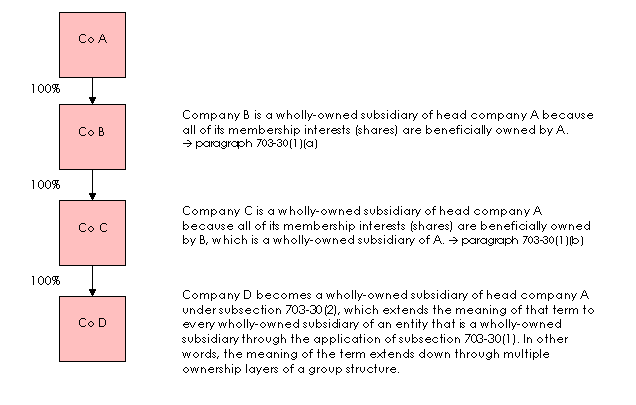
Wholly-owned subsidiary - the special rules
It is possible for an entity to be a wholly-owned subsidiary of a holding company despite failing the general test contained in section 703-30, through the operation of special rules that cover the following situations:
- •
- An exception to the general rule that all membership interests in a company must be beneficially owned by members of the group applies to certain ordinary shares that are issued under an arrangement for employee shareholdings, providing they account for 1% or less of the ordinary shares in the company. → section 703-35, ITAA 1997
- •
- An entity that would otherwise be prevented from being a wholly-owned subsidiary because it is held through a non-fixed trust may qualify as a wholly-owned subsidiary. → section 703-40, ITAA 1997
Rule 1 - Disregarding employee shareholdings
Where certain ordinary shares issued under an arrangement for employee shareholdings represent 1% or less of the ordinary shares in the company, those shares can be disregarded in determining whether a company is a wholly-owned subsidiary of another. The employee share scheme under which shares have been issued is not restricted to Division 13A employee share schemes. → subsection 703-35(4)
The following requirements must be met:
- •
- the share must have been acquired:
- -
- by the entity (e.g. an individual) in relation to the employment of the entity or an associate or services provided by the entity or an associate in the circumstances described in subsections 139C(1) and (2) of the ITAA 1936, or
- -
- as the result of the exercise of a right that the entity acquired from holding employee share scheme shares
- •
- all of the shares available for acquisition under the scheme must be ordinary shares or rights in respect of ordinary shares
- •
- at the time the share was acquired, the entity did not hold a legal or beneficial interest in more than 5% of the shares in the company, and was not in a position to cast or control the casting of more than 5% of the maximum number of votes at a general meeting, as required by subsections 139CD(6) and (7) of the ITAA 1936
- •
- the company is not covered by section 139DF of Division 13A of the ITAA 1936 where the business of the company is the acquisition, sale or holding of shares, securities or other investments, and the entity is employed by both that company and another company in the same company group
- •
- at the time at which the share was acquired, an offer to acquire shares or rights in the company or in a holding company must have been available to 75% of the permanent employees of the employing company (the employer).
→ subsection 703-35(5)
If all of the conditions in the above dot points are satisfied except for the last, the share may still be disregarded in certain circumstances. → subsection 703-35(6)
Example: Wholly-owned subsidiary - disregarding employee shareholdings
- •
- All entities are Australian residents and are eligible to be part of a consolidatable group.
- •
- The 10,000 ordinary shares in company B that are not owned by company A were issued to employees in respect of their employment by company B. The share offer to employees was open to all permanent employees of company B. None of the employees of company B are also employed by company A.
Figure 3

Rule 2 - Entity held through non-fixed trust
Section 703-40 effectively allows an entity that is held through a non-fixed trust to be a wholly-owned subsidiary of the head company if it would have been a wholly-owned subsidiary had it been held by a fixed trust. This provision is needed to remove any concerns about the ability of the objects of a non-fixed trust to beneficially own the property of that trust.
Interposed entities
Generally, a company, trust or partnership will only be a subsidiary member of a consolidatable or consolidated group where all the entities interposed between it and the head company are also subsidiary members of the group. However, there are two exceptions to this rule:
Interposed nominees
Where an interposed entity holds membership interests in a subsidiary member only as a nominee of either the head company or one or more subsidiary members of the group, the nominee (which has legal but not beneficial ownership of the interests) is not a member of the group, but the entity in which the nominee holds membership interests is a member of the group.
→ subsection 703-45(2), ITAA 1997
→ 'Business structures and eligibility', C1-2 , example 6
Interposed foreign residents: transitional exception
In certain circumstances an Australian-resident entity may still qualify as a subsidiary member even where one or more non-member foreign-resident entities are interposed between it and the head company. These rules operate differently depending on whether the Australian-resident entity being tested is a company, trust or partnership. → Division 701C, Income Tax (Transitional Provisions) Act 1997 (IT(TP)A 1997)
Test entity is a company
→ section 701C-10, IT(TP)A 1997
If the test entity is a company, it may still qualify as a subsidiary member at a particular time (the test time) if all of the following requirements are met:
- •
- At least one entity interposed between the test entity and the head company is either a non-resident company or non-resident trust.
- •
- Each of the interposed entities is one of the following:
- -
- a subsidiary member of the group
- -
- a non-resident company
- -
- a non-resident trust
- -
- a nominee entity that holds membership interests in the test entity, or in an interposed entity, on behalf of another member of the group, a non-resident company or a non-resident trust, or
- -
- a partnership, where each partner is a non-resident company or a non-resident trust.
- •
- The test entity would be a subsidiary member of the group if it was assumed that each of the following interposed entities was a subsidiary member of the group:
- -
- each interposed entity that is a non-resident company, and
- -
- each interposed entity that is a non-resident trust.
Additional requirements relating to timing of the test
This exception operates as a transitional measure. One reason for this is that it is not possible to reset the cost bases of assets of a transitional foreign-held subsidiary, because the cost setting rules cannot be applied to that subsidiary through an interposed non-resident entity. Any modifications that are made to apply the cost setting rules to a non-resident entity would be both complex and affect the integrity of the cost setting rules. → Explanatory Memorandum to New Business Tax System (Consolidation and Other Measures) (No. 2) Bill 2003, paragraphs
4.34 - 4.37
Testing for membership of a consolidatable group
If testing for membership of a consolidatable group, the test time must be before 1 July 2004.
Testing for membership of a consolidated group at formation time
If testing for membership of a consolidated group at the time it forms, the test time must be before 1 July 2004.
Test for membership of a consolidated group after formation
Where:
- •
- a consolidated group is being tested after formation, and
- •
- at the test time the test entity has one or more of its membership interests held by a non-resident company or non-resident trust (or a nominee of a non-resident company or non-resident trust), or by a partnership in which each of the partners is a non-resident company or non-resident trust,
both of the following conditions must be satisfied for the test entity to qualify at test time for membership of the group:
- •
- The test entity must have been a subsidiary member of the group at formation time (which means formation time must have been before 1 July 2004) and not ceased to be a subsidiary member of the group since that time.
- •
- At formation time, a non-resident company or non-resident trust (or a nominee of a non-resident company or non-resident trust), or a partnership in which each of the partners is a non-resident company or non-resident trust, must have held one or more membership interests in the test entity.
These rules for testing for membership after formation have two primary outcomes:
1. They ensure that a resident entity acquired after formation by a consolidated group that has an interposed foreign-resident entity (IFRE) will not qualify for membership of the group if one or more of the membership interests in the newly-acquired entity are held directly by the IFRE.
2. They ensure that an entity that qualified as a subsidiary member of a consolidated group at formation time becomes ineligible if a restructure of the consolidated group takes place after formation time which results in one or more membership interests in that subsidiary member being held directly by an IFRE, if no such interest was held directly by a non-resident at formation time.
Example: Interposed entities - application of section 703-45 of the ITAA 1997 and section 701C-10 of the IT(TP)A 1997 where test entity is a company
- •
- All entities in the consolidated group below are Australian residents unless otherwise indicated. The Australian-resident companies are standard companies paying tax at the general company tax rate. None of the Australian-resident entities are 'excluded entities', as per section 703-20.
- •
- Companies B and C are wholly-owned subsidiaries of company A.
- •
- The consolidated group was formed on 1 July 2002 and the structure has remained unchanged since.
- •
- The aim is to determine whether Co C is a subsidiary member of the group at 1 July 2004.
Figure 4
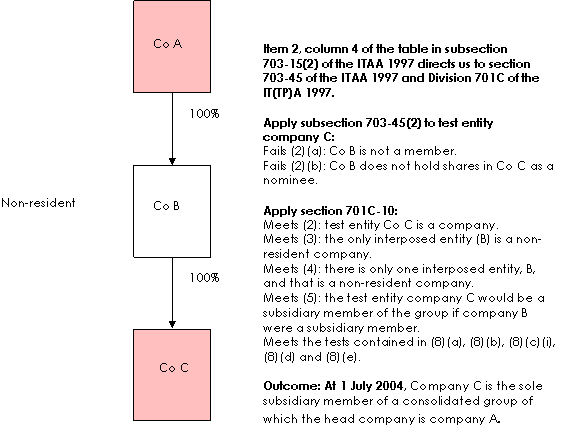
Test entity is a trust or partnership
→ section 701C-15, IT(TP)A 1997
If the test entity is a trust or partnership, it will only be a subsidiary member of the group at a particular time (the test time) where:
- •
- at least one of the interposed entities is a company that is itself a subsidiary member through the application of section 701C-10 of the IT(TP)A 1997, and
- •
- the trust or partnership being tested would be a subsidiary member if the membership interests beneficially owned by each of the interposed entities that is a company qualifying as a subsidiary member through the application of section 701C-10 were instead beneficially owned by the head company.
This effectively means that the interposed foreign resident test will not be satisfied where the test entity is a trust of which the membership interests are beneficially owned directly by a non-resident.
It also means that the interposed foreign resident test applying where the test entity is a trust is also transitional in nature, because the test will only be met where there is a company interposed between the test entity trust and the head company that has met all the requirements of section 701C-10.
Example: Interposed entities - application of section 703-45 of the ITAA 1997 and section 701C-15 of the IT(TP)A 1997 where test entity is a trust
- •
- All entities in the two groups illustrated in Figures 5 and 6 (next page) are Australian residents except where otherwise indicated. The Australian-resident companies are standard companies paying tax at the general company tax rate. None of the Australian-resident entities are 'excluded entities', as identified by section 703-20. Companies B and C and fixed trust T are wholly-owned subsidiaries of company A.
- •
- Co A chooses to form a consolidated group on 1 July 2002.
- •
- The aim is to determine which entities will be subsidiary members of the groups in Figures 5 and 6 respectively at formation time.
Figures 5 and 6 highlight the difference in the operation of the section where the membership interests in the trust are held by the interposed non-resident company, as against being held by a resident company.
The rationale for the different outcomes with regard to the eligibility of fixed trust T to be a group member is that, in Figure 5, T distributes to a non-resident. When T makes a distribution to non-resident C in Figure 5, the taxable income of C is calculated by reference to the net income of T. However, if T were a member of a consolidated group, all of T's income and expenditure would be attributed to head company A (single entity principle). Such a computation of trust net income is not possible. Hence in this situation the interposed entity rules must be designed to prevent T from being a member of a consolidatable or consolidated group. In Figure 6, T distributes to another member of the consolidatable group, so the problem would not arise.
Figure 5
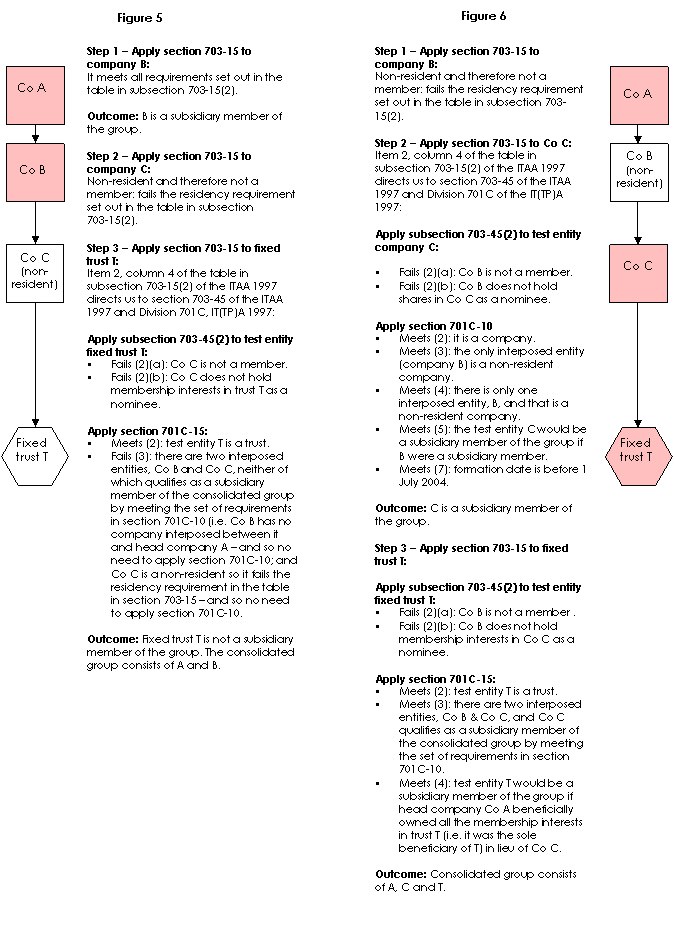
Example: A company as a member under the IFRE tests - formation before 1 July 2004
In Figure 7, an IFRE is interposed between the head company and its wholly-owned Australian-resident subsidiary company ACo. ACo follows the IFRE as the first Australian-resident company, so it can become a member of the consolidated group under the interposed foreign-resident entity tests. The head company must hold all the membership interests in the IFRE directly or through its wholly-owned subsidiaries who are also members of the consolidated group. In this example, the head company can own the IFRE directly or through SubCo or together with SubCo.
Figure 7: A company as a member under the IFRE tests
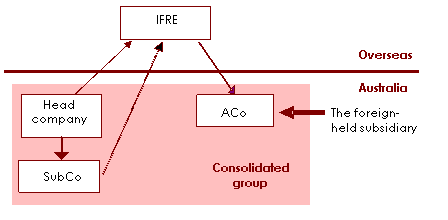
Example: A trust as a member under the IFRE tests - formation before 1 July 2004
In Figure 8, resident trust T is a wholly-owned subsidiary of company ACo, which is a subsidiary member of the consolidated group under the IFRE tests, so trust T and its subsidiary company BCo can be members of the consolidated group.
Figure 8: A trust as a member under the IFRE tests
Example: A trust ineligible to be a member under the IFRE tests
In Figure 9, resident trust T cannot be a member of a consolidated group under the IFRE tests as it is the first resident entity following the IFRE. Nor can BCo, which is a subsidiary of trust T, be a member.
Figure 9 : When a trust cannot be a member under the IFRE tests
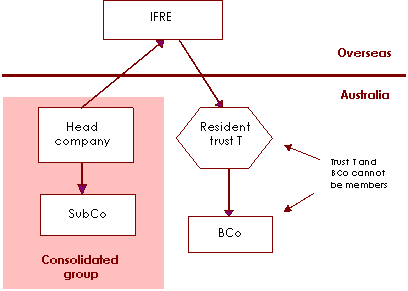
Example: A wholly-owned group that has a foreign-held subsidiary consolidates after 1 July 2004
HCo, ACo, SubCo and NR are members of a wholly-owned group. If the group decides to consolidate after 1 July 2004, ACo cannot become a member of the consolidated group.
Figure 10
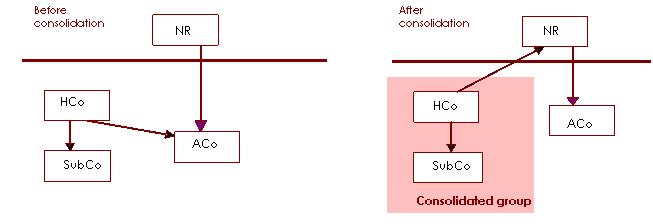
The following three examples show how the rules apply to consolidated groups after formation.
Example: A wholly-owned non-resident subsidiary of the head company acquires a resident entity after the group has formed
HCo is the head company of a consolidated group and NR is its wholly-owned non-resident subsidiary. ACo is an unrelated Australian-resident company. NR acquires all the membership interests in ACo after consolidation. ACo cannot become a member of the consolidated group.
Figure 11

Example: A wholly-owned non-resident subsidiary of the head company acquires a member of the consolidated group in which it had no membership interests
HCo is the head company of a consolidated group formed by HCo, SubCo and ACo. NR is a non-resident wholly-owned subsidiary of HCo. NR acquires all the membership interests in ACo from HCo. ACo cannot continue to be a member because the non-resident interposed entity NR did not have any membership interests in ACo at the time the consolidated group was formed.
Figure 12

Example: A wholly-owned non-resident subsidiary of the head company acquires a member of the consolidated group in which it had some membership interests at the formation time
ACo is a transitional foreign-held subsidiary member of the consolidated group formed before 1 July 2004; i.e. NR had some membership interests in ACo at the formation time. NR acquires HCo's membership interests in ACo, and ACo becomes a wholly-owned subsidiary of NR. ACo can continue to be in the consolidated group as a foreign-held subsidiary member.
Figure 13

References
Income Tax Assessment Act 1997 , Division 703 ; as amended by New Business Tax System (Consolidation) Act (No. 1) 2002 (No. 68 of 2002), Schedule 1
Income Tax Assessment Act 1997 , Subdivision 960-G, section 995-1; as amended by New Business Tax System (Consolidation) Act (No. 1) 2002 (No. 68 of 2002), Schedule 5
Income Tax Assessment Act 1997 , subsection 703-20(2); as amended by New Business Tax System (Consolidation, Value Shifting, Demergers and Other Measures) Act 2002 (No. 90 of 2002), Schedule 1
Income Tax Assessment Act 1997 , subsection 703-15(2) (cell at table item 2, column 4); as amended by New Business Tax System (Consolidation and Other Measures) Act 2003 (No. 16 of 2003), Schedule 16, Part 1
Income Tax Assessment Act 1997 , section 703-45; as amended by New Business Tax System (Consolidation and Other Measures) Act 2003 (No. 16 of 2003), Schedule 16, Part 1
Income Tax Assessment Act 1997 , Subdivision 713-C ; as inserted by Tax Laws Amendment (2004 Measures No. 2) Act 2004 (No. 83 of 2004), Schedule 2, Part 2
Income Tax Assessment Act 1997 , section 995-1 (definitions of 'partnership' and 'limited partnership'); as amended by Tax Laws Amendment (2004 Measures No. 2) Act 2004 (No. 83 of 2004), Schedule 3 and Taxation Laws Amendment Act No. 1, 2004 (No. 101 of 2004), Schedule 10
Income Tax Assessment Act 1997 , subsection 703-30(3) ; as inserted by Tax Laws Amendment (2004 Measures No. 6) Act 2005 (No. 23 of 2005), Schedule 1, Part 2
Income Tax (Transitional Provisions) Act 1997 , Division 701C ; as inserted by New Business Tax System (Consolidation and Other Measures) Act 2003 (No. 16 of 2003), Schedule 16, Part 2
Income Tax Assessment Act 1997 , Division 50, Subdivisions 375-H, 974-B and 974-C, section 995-1
Income Tax Assessment Act 1936 , subsection 6(1) , sections 6H and 23G , Divisions 5A , 6 , 6B , 6C and 13A
Income Tax Rates Act 1986 , section 3
Taxation determinations TD 2004/42 - Income tax: consolidation: capital gains: does the single entity rule in section 701-1 of the Income Tax Assessment Act 1997 affect the application of CGT event I1 in section 104-160 if a company which is a subsidiary member of a consolidated group stops being an Australian resident?
History
Revision history
Section C1-1 first published (excluding drafts) 2 December 2002 and updated 28 May 2003.
Further revisions are described below.
| Date | Amendment | Reason |
|---|---|---|
| 23.12.03 | Change to the definition of a 'corporate limited partnership' (p. 6). | Reflects amendments to ITAA 1936 by Taxation Laws Amendment (Venture Capital) Act 2002 (No. 136 of 2002). |
| 23.4.04 | Inclusion of note to the effect that rights and options in a joining company are not membership interests for purpose of determining whether a company is wholly owned (p. 13). | For clarification. |
| 14.7.04 | Note on recent and proposed changes to consolidation rules, pp. 2, 6, 13. | Recent and proposed legislative amendments. |
| 26.10.04 | Updates to notes advising of recent and proposed amendments affecting the consolidation status of corporate unit trusts and public trading trusts, corporate limited partnerships and companies under external administration. | Legislative Amendments |
Proposed changes to consolidation
Proposed changes to consolidation announced by the Government are not incorporated into the Consolidation reference manual until they become law. In the interim, information about such changes can be viewed at:
- •
- http://assistant.treasurer.gov.au (Assistant Treasurer's press releases)
- •
- www.treasury.gov.au (Treasury papers on refinements to the consolidation regime).
Current at 26 October 2005
Principles of the law of trusts, HAJ Ford and WA Lee, Law Book Company, at paragraph 1000
The definition of wholly-owned subsidiary in section 703-30 derives from the definition of '100% subsidiary' in section 975-505 (ITAA 1997), which in turn is similar to the approach adopted in former subsections 80G(2) and 80G(3) of the ITAA 1936 dealing with the meaning of 'subsidiary company', discussed in IT 2465 (in particular, paragraphs 13-18).
